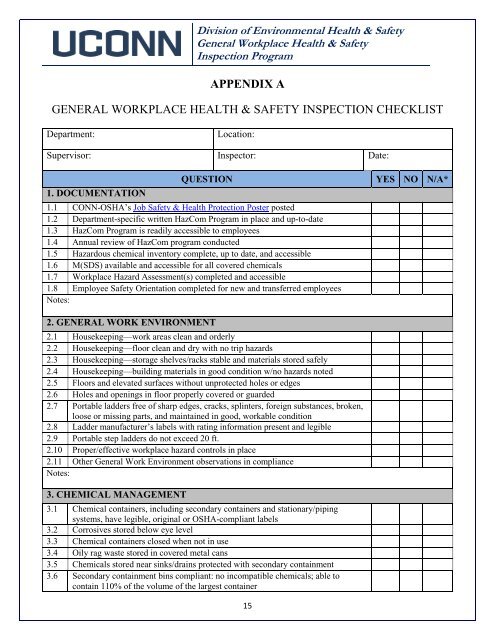APPENDIX A GENERAL WORKPLACE HEALTH & SAFETY INSPECTION CHECKLIST
General Workplace Safety & Health Inspection Form - Environmental ...
General Workplace Safety & Health Inspection Form - Environmental ...
Create successful ePaper yourself
Turn your PDF publications into a flip-book with our unique Google optimized e-Paper software.
Division of Environmental Health & SafetyGeneral Workplace Health & SafetyInspection Program<strong>APPENDIX</strong> A<strong>GENERAL</strong> <strong>WORKPLACE</strong> <strong>HEALTH</strong> & <strong>SAFETY</strong> <strong>INSPECTION</strong> <strong>CHECKLIST</strong>Department:Location:Supervisor: Inspector: Date:1. DOCUMENTATIONQUESTION1.1 CONN-OSHA’s Job Safety & Health Protection Poster posted1.2 Department-specific written HazCom Program in place and up-to-date1.3 HazCom Program is readily accessible to employees1.4 Annual review of HazCom program conducted1.5 Hazardous chemical inventory complete, up to date, and accessible1.6 M(SDS) available and accessible for all covered chemicals1.7 Workplace Hazard Assessment(s) completed and accessible1.8 Employee Safety Orientation completed for new and transferred employeesNotes:YES NO N/A*2. <strong>GENERAL</strong> WORK ENVIRONMENT2.1 Housekeeping—work areas clean and orderly2.2 Housekeeping—floor clean and dry with no trip hazards2.3 Housekeeping—storage shelves/racks stable and materials stored safely2.4 Housekeeping—building materials in good condition w/no hazards noted2.5 Floors and elevated surfaces without unprotected holes or edges2.6 Holes and openings in floor properly covered or guarded2.7 Portable ladders free of sharp edges, cracks, splinters, foreign substances, broken,loose or missing parts, and maintained in good, workable condition2.8 Ladder manufacturer’s labels with rating information present and legible2.9 Portable step ladders do not exceed 20 ft.2.10 Proper/effective workplace hazard controls in place2.11 Other General Work Environment observations in complianceNotes:3. CHEMICAL MANAGEMENT3.1 Chemical containers, including secondary containers and stationary/pipingsystems, have legible, original or OSHA-compliant labels3.2 Corrosives stored below eye level3.3 Chemical containers closed when not in use3.4 Oily rag waste stored in covered metal cans3.5 Chemicals stored near sinks/drains protected with secondary containment3.6 Secondary containment bins compliant: no incompatible chemicals; able tocontain 110% of the volume of the largest container15
Division of Environmental Health & SafetyGeneral Workplace Health & SafetyInspection Program3.7 Flammables in excess of 30 gallons stored in rated flammable cabinet/refrigerator3.8 Flammable storage areas labeled as such or with a red flammable diamond sticker3.9 Flammables/aerosol cans stored away from heat/ignition sources3.10 Flammable storage cabinet contents do not exceed 55 gallons (or as perUCFD/EHS)3.11 Flammables liquids stored separately from incompatible materials3.12 Compressed Gas Cylinders—stored upright in well-ventilated area; individuallyfastened or secured in cage)3.13 Compressed Gas Cylinders—cap or regulator in place3.14 Compressed Gas Cylinders—labeled and stored so label can be easily read3.15 Compressed Gas Cylinders—valves accessible3.16 Compressed Gas Cylinders— kept away from ignition sources3.17 Compressed Gas Cylinders— incompatible gases (e.g., O 2 & acetylene) stored ≥20ft. apart or separated by ≥5 ft. high firewall with ½ hour fire rating3.18 Compressed Gas Cylinders— empty and full cylinders stored separately3.19 Compressed Gas Cylinders— secured while transported3.20 Procedures to address chemical spills in place and communicated with employees3.21 Other Chemical Management observations in complianceNotes:4. HAZARDOUS WASTE4.1 Hazardous waste labeled as “Hazardous Waste” with full chemical names4.2 Hazardous waste containers in good condition with tight-fitting caps/lids4.3 Designated hazwaste storage areas labeled “Satellite Accumulation Area”4.4 Volume of total hazwaste is
Division of Environmental Health & SafetyGeneral Workplace Health & SafetyInspection Program5.13 Other PPE observations in complianceNotes:6. EMERGENCY EQUIPMENT & EGRESS6.1 Worksites with corrosives have proper emergency eyewash/showerequipment6.2 Eyewash/shower stations within 10 seconds or 100 ft. of uninterruptedwalk6.3 Plumbed eyewash stations tested weekly6.4 Fire extinguishers and alarms accessible and unobstructed6.5 Sprinkler systems have 18 inch vertical and horizontal clearance zones6.6 Exit doors unlocked and unobstructed6.7 Exits marked with readily visible signs6.8 Routes of egress (exits, aisles, hallways and stairways) free of obstructions6.9 Other Emergency Equipment & Egress observations in complianceNotes:7. ELECTRICAL <strong>SAFETY</strong>7.1 Employees know the location of electrical panels/disconnect switches/estops7.2 Circuit breakers labeled properly7.3 Electrical panels/disconnect switches/e-stops unobstructed; 3 ft clearancemaintained in front of electrical panels7.4 Electrical boxes have covers in place and not damaged7.5 Electrical cords in good condition—no damaged insulation, exposed wiresor missing ground pins7.6 Electrical cords’ use, size and rating appropriate for usage and environment7.7 Extension cords used only on a temporary basis7.8 Multi-tap power strips are used long-term only with computer or electronicequipment7.9 Extension cords are not linked together (daisy-chaining).7.10 Electrical cords do not run through doors, walls or partitions, under rugs, orabove drop ceilings; they are not tied in knots, draped overhead, or attachedto building structures.7.11 Electrical circuits not overloaded7.12 Electrical equipment not in wet/damp locations, unless rated as such7.13 Live parts effectively insulated or physically guarded7.14 GFCIs installed near wet environments, as required7.15 Flammable materials kept away from electrical equipment7.16 Other Electrical Safety observations in complianceNotes:17
Division of Environmental Health & SafetyGeneral Workplace Health & SafetyInspection Program8. MACHINE GUARDING8.1 Machinery and equipment with ingoing nip points, rotating parts, flyingchips and sparks properly guarded.8.2 Bench grinder benches adjusted to no greater than 1/8 inch from wheel;tongue guards adjusted no greater than ¼ inch from wheel.8.3 Other Machine Guarding observations in complianceNotes:9. POWERED INDUSTRIAL TRUCKS9.1 Worksite follows UConn’s Powered Industrial Truck Program9.2 Operators of lift trucks have a Lift Truck Operator Endorsement and carryit with them whenever they operate a lift truck.9.3 Periodic evaluations and any necessary refresher training conducted anddocumented to maintain a Lift Truck Operator’s Endorsement9.4 Lift truck inspections performed9.5 Other Powered Industrial Truck observations in complianceNotes:10. ADDITIONAL CRITERIA10.1 Other observations in compliance 1:10.2 Other observations in compliance 2:10.3 Other observations in compliance 3:Notes:*N/A—Not Applicable or Not Assessed18

















